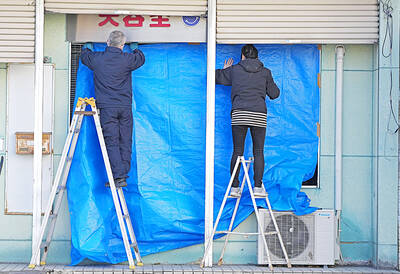US forensic scientist Dr. Henry Lee (
"I discovered many pieces of debris on the windshield and on the dashboard. That means the bullet came from a location outside the vehicle.
"In addition, according to the forensic analysis we did at the scene and patient records and X-ray photos provided by the hospital, I can confirm that Lu was injured by the same bullet that went through the windshield," Lee said during a press conference at Tainan's Tayih Landis Hotel.
Lee and forensic photographer Calvin Ostler flew to Tainan on Friday to visit the medical personnel who attended to the president and the vice president after the shooting.
After staying at the hospital for nearly four hours, Lee and Ostler went to the crime scene on Tainan City's Jinhua Road to recreate the incident and try to determine where the shots might have come from.
To help Lee carry out his research at the crime scene, the Tainan City Police Department sealed off a section of the road and requested that residents there turn off their lights so that Lee and his colleagues could use a laser instrument to help them determine where the shots might have come from and at what angles the bullets might have travelled.
The crime-scene research lasted for four and a half hours.
Investigators now believe that the gunman might have fired the first shot from in front of No. 18, Section 3, Jinhua Road. That would mean that there was a distance of approximately 8m between the shooter and the president's vehicle at the time the shots were fired.
The first bullet went through the Jeep's windshield and slightly wounded Lu in the right knee.
The suspect then fired a second shot, which grazed Chen's stomach.
During yesterday's press conference, Lee said that it is difficult to figure out the exact location of the shooter.
He said that forensic scientists can only determine a potential area from which a bullet might have been fired, which might help investigators identify a suspect from available video.
"We can only make an assumption about the area in which the suspect could have been located," he said.
"All our research is based on police reports about where the two bullet casings were found, how the vehicle was moving and how many people were at the scene," Lee said.
"However, none of the information was 100-percent accurate so it is impossible to come up with a precise analysis."
Before he left for Taipei, Lee said that he would utilize the "Ultralight" machine that he and his colleagues brought from the US to scan evidence at the National Police Administration's Criminal Investigation Bureau, and that he will update the public again when appropriate.
Once in Taipei, Lee immediately went to Lu's residence to examine her wound.
Lee, two other US forensic scientists and a Connecticut lawyer were scheduled to leave Taiwan today.

Taiwanese were praised for their composure after a video filmed by Taiwanese tourists capturing the moment a magnitude 7.5 earthquake struck Japan’s Aomori Prefecture went viral on social media. The video shows a hotel room shaking violently amid Monday’s quake, with objects falling to the ground. Two Taiwanese began filming with their mobile phones, while two others held the sides of a TV to prevent it from falling. When the shaking stopped, the pair calmly took down the TV and laid it flat on a tatami mat, the video shows. The video also captured the group talking about the safety of their companions bathing

US climber Alex Honnold is to attempt to scale Taipei 101 without a rope and harness in a live Netflix special on Jan. 24, the streaming platform announced on Wednesday. Accounting for the time difference, the two-hour broadcast of Honnold’s climb, called Skyscraper Live, is to air on Jan. 23 in the US, Netflix said in a statement. Honnold, 40, was the first person ever to free solo climb the 900m El Capitan rock formation in Yosemite National Park — a feat that was recorded and later made into the 2018 documentary film Free Solo. Netflix previewed Skyscraper Live in October, after videos

Starting on Jan. 1, YouBike riders must have insurance to use the service, and a six-month trial of NT$5 coupons under certain conditions would be implemented to balance bike shortages, a joint statement from transportation departments across Taipei, New Taipei City and Taoyuan announced yesterday. The rental bike system operator said that coupons would be offered to riders to rent bikes from full stations, for riders who take out an electric-assisted bike from a full station, and for riders who return a bike to an empty station. All riders with YouBike accounts are automatically eligible for the program, and each membership account

A classified Pentagon-produced, multiyear assessment — the Overmatch brief — highlighted unreported Chinese capabilities to destroy US military assets and identified US supply chain choke points, painting a disturbing picture of waning US military might, a New York Times editorial published on Monday said. US Secretary of Defense Pete Hegseth’s comments in November last year that “we lose every time” in Pentagon-conducted war games pitting the US against China further highlighted the uncertainty about the US’ capability to intervene in the event of a Chinese invasion of Taiwan. “It shows the Pentagon’s overreliance on expensive, vulnerable weapons as adversaries field cheap, technologically